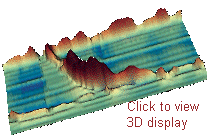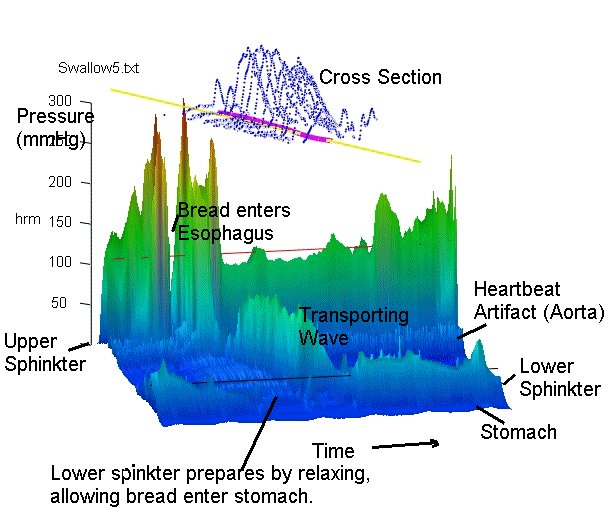How to Read the Swallow Pressure Animations
 The animations below show 3D-diagrams of pressure waves in the esophagus when bread or water is swallowed. Pressures are indicated as bars in the vertical direction, time passes from left to right.
The animations below show 3D-diagrams of pressure waves in the esophagus when bread or water is swallowed. Pressures are indicated as bars in the vertical direction, time passes from left to right.
When your browser supports Java-Applets, you can also try the interactive 3D-display of swallow pressures.
The high mountain ridge in the background comes from the upper esophageal sphincter, which is normally closed, indicated by high pressure. Only for the short moment when food enters the esophagus it opens by releasing pressure, closing immediately after food has passed. At about the same time, the lower esophageal sphincter, represented by the ridge in the front, opens by relaxing, giving free passage to the stomach.
The diagonal ridge from top left to lower right shows the wave transporting the food down the esophagus. If we could demonstrate the way of the food bolus, we would see it like a ball sliding down the base of the ridge.
When the food bolus has entered the stomach, the lower sphincter closes again to avoid that food and gastric acid flows back into the esophagus. When this protective reflex is impaired, patients can suffer from gastro-esophageal reflux disease (GERD).

Animated Swallows
The animations of the swallows will open in a separate window. Note that each animation has a size of 3 MB, so download may need some time with slow Internet connections. The interactive display will download a Java-Applet of 750kB the first time it is called, but loading of data packet is fast.
- Interactive 3D-display (requires Java)
- Water Swallow 1
- Water Swallow 2
- Water Swallow 3
- Bread Swallow

 Dr. Dieter Menne
Dr. Dieter Menne 07072 1263 688
07072 1263 688
